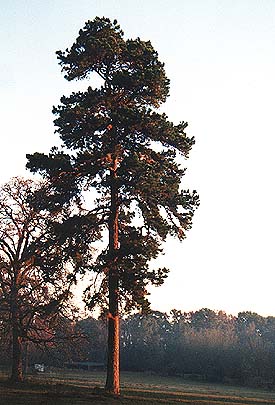
Pinus taeda
"... pines seem to me the best interpreters of
the winds. They are mighty waving golden-rods, ever in tune,
singing and writing wind music all their long century
lives." -- John Muir, A Wind Storm in the Forests of
the Yuba, 1878
"But, ah! the needles of the pine, how they
shine... Every tree is lit with the most subdued, but clear
ethereal light... And as they rock and wave in the strong wind,
the light courses up and down... like looms above the forest,
when the shuttle is thrown between the light woof and the dark
web." -- Henry David Thoreau, March 1858
Are Pines the "Best" Trees ?

Pinus taeda
AH, COME ON...
WELL... making no attempt to compensate for the obvious bias of this pinetum website, the personal answer to this question, all things considered, is YES. (And the chief rivals would be other Pinaceae family genera such as Pseudotsuga (Douglas fir), Tsuga (hemlock), or Cedrus (true cedar)). Why pine?
First, it is admitted that the "best" part of the above question invites a nonscientific subjective answer using esthetic, cultural and emotional arguments which another individual could just as easily use to plead the case for some totally different species, even an angiosperm.
However, there are special physical qualities of this genus. It has more species, geographic distribution and morphologic diversity than any of the other gymnosperms, with more tendency for uniquely picturesque individuals than, say, spruces and firs. The pines have oils that transpirate through their needle stomata and evaporate from sap resin in wounds and growing cones which provides a pleasant fragrance unmatched by other genera. Many of them have edible seeds that provide an essential link in the ecology of their habitats. A special sound when the wind blows through their needles, a special sun and shadow pattern on the ground under a pine tree -- that sort of stuff which sounds pretty corny but which has long been a source of inspiration for poets, painters, and musicians. Some of this veneration really does relate to their unique physical beauty and longevity. They are a symbol of long life and beauty in much of the Far East, sacred to Zeus and the people of ancient Corinth, worshiped in Mexico and Central America and an object of affection for early American colonists. Longfellow wrote "we are all poets when we are in the pine woods". The genus Pinus contains the oldest and most ruggedly beautiful living individuals, i.e. the intermountain bristlecone pine, on Earth. And I have seen equally attractive whitebark, limber, foxtail, southwestern white, tablemountain and other pine species individuals
Unfortunately for these trees, because of their great size and capacity for rapid growth, they have considerable economic significance -- the house where this is now being typed was framed with southern yellow ("number 2") pine and, although I wish it had been oak or maple I might not (given the hypothetical choice) have opted for the added cost of angiosperm wood. One of the earliest references to the consumption of the world's resources by man is in Genesis, the part admonishing man to be fruitful, multiply, fill the Earth and subdue it. Genesis 1:29: "And God said, "Behold, I have given you every plant yielding seed which is upon the face of all the earth, and every tree with seed in its fruit: you shall have them for food." Could this mean that the gymnosperms (with naked seeds) were meant to be spared? Unfortunately, not true. We know from the epic of Gilgamesh that the great cedar forests of Lebanon and Eastern Turkey (and pine) were under assault at least a thousand years before Abraham (and probably finished off by the wise King Solomon when he built his magnificent temple that is now long gone).
Right here in Missouri, the southeast and southcentral part of the state was entirely covered by shortleaf pine forest which was exterminated by the lumber companies which were here from about 1870 to 1910 and then they moved on. In the 1970's several Missouri newspapers published the words of an old man named Jimmy Simpson who was born in 1888 in an area known as the Irish Wilderness, a sparsely settled area in the midst of the great shortleaf pine forest. He remembered the pine forest in his youth, but had lived most of his life in the oak-hickory forest, which replaced the pine.
This is what Jimmy Simpson said: "Oh, if you could have seen it then. If you could have seen the forest then. You'd have thought you had a forest, then." These simple but powerful words of an old man state the case for pines better than I can.